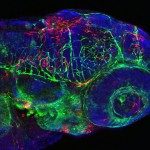Lien vers Pubmed [PMID] – 9032976
Transgenic Res. 1997 Jan;6(1):37-40
The Escherichia coli beta-galactosidase gene is frequently used as a reporter gene in transgenic studies because its activity can be easily detected at the cellular level. Here we report a procedure for monitoring beta-galactosidase activity directly in tissue sections, which involves the use of a mixture of ethanol and poly-ethylene-glycol as a fixative (Kryofix) and a special paraffin characterized by a lower fusion point of 42 degrees C. After embedding and cutting, the sections are stained by the chromogenic substrate 5-bromo-4-chloro-3-indoyl-beta-D galactopyranoside (X-Gal). This procedure allows both the retention of a high level of beta-galactosidase activity and the preservation of good tissue morphology. Furthermore, it can be combined with immunohistochemical methods to detect other cellular components without compromising reporter gene detection.

